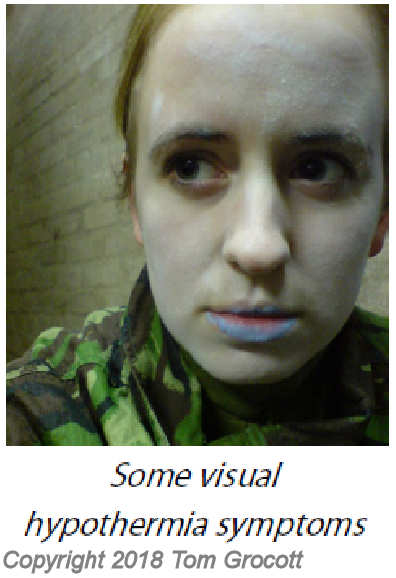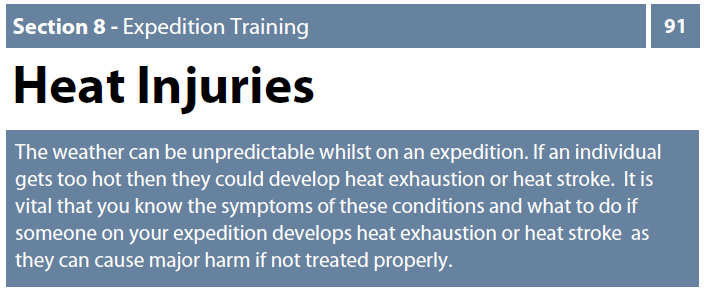Expedition First Aid Training
Section 8 - Expedition Training
Cold Injuries
The weather can be unpredictable whilst on an expedition. If an individual gets too cold they could develop hypothermia. It is vital that you know the symptoms of this condition and what to do if someone on your expedition develops hypothermia as it can be fatal if not treated properly. • Hypothermia is a condition that develops when the body looses more heat than it produces, and the casualty gets too cold.
• Staff must be informed if you think someone has developed hypothermia.
Symptoms
• Shivering.
• Slurring words.
• Lack of co-ordination.
• Irrational behaviour .
• Inability to recall simple facts (e.g. being unable to recite their address).
• Quiet and withdrawn.
• Blue lips.
• A change in usual behaviour.
• Someone suffering from hypothermia may not have all of these symptoms. One symptom alone may not represent hypothermia.
Treatment
• The casualty needs to be warmed, but not too fast – if they have got cold over a long period of time they need to be warmed slowly.
• Shelter the casualty (tent or group shelter). Insulate them with sleeping bag(s) or extra layers.
• If they are in wet clothes these need to be removed and replaced with dry ones.
• Give them a warm (not hot) drink if available and sugary food to replace lost energy.
• Make sure other group members also stay warm.


The weather can be unpredictable whilst on an expedition. If an individual gets too hot then they could develop heat exhaustion or heat stroke. It is vital that you know the symptoms of these conditions and what to do if someone on your expedition develops heat exhaustion or heat stroke as
they can cause major harm if not treated properly.
• Heat Exhaustion is where you become very hot and start to lose water or salt from your body which leads to a general feeling of being unwell. It may develop into heat stroke if not treated.
• Heat Stroke is where the body is no longer able to cool itself and a person's body temperature becomes dangerously high. Heatstroke is less
common, but more serious. It can put a strain on the brain, heart, lungs, liver and kidneys, and can be life-threatening.
• Staff must be informed if you think someone has developed a heat injury.
Symptoms
• Someone suffering from heat exhaustion or heat stroke may not have all of these symptoms. One symptom alone may not
represent heat exhaustion or heat stroke.
• Get casualty to drink water and seek help immediately.
• Severe headache • Slurring words
• Lack of co-ordination • Cramps
• Rapid shallow breathing • Lack of sweating despite heat.
• Dizziness • Unconsciousness
Treatment
• Get out of the sun into shelter (under tree etc).
• Use cool water to cool the casualty. If possible submerse casualty completely. Unlike hyperthermia the casualty can be cooled rapidly.
Keep hydrated to avoid heat injuries.
The article below is an extract from the First Class Cadet Resource Book available exclusively from www.cadetdirect.com. Please note this information is subject to Copyright 2018 Thomas Grocott. Not for reproduction. Thomas Grocott has asserted his right to be identified as author of this work in accordance with the Copyright, Designs and Patents Act 1988. All rights reserved. Some images in this publication are Crown Copyright and contain public sector information licensed under the Open Government Licence v3.0.




